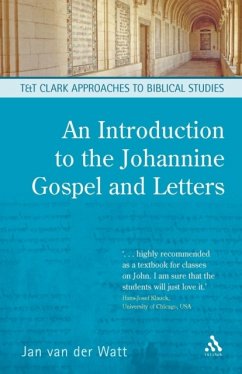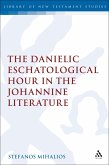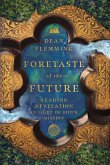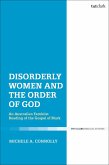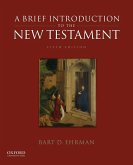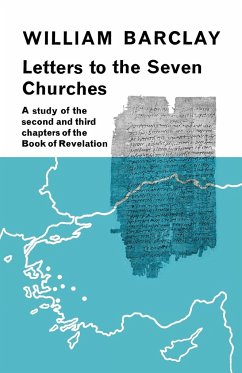Jan van der Watt
An Introduction to the Johannine Gospel and Letters
Jan van der Watt
An Introduction to the Johannine Gospel and Letters
- Broschiertes Buch
- Merkliste
- Auf die Merkliste
- Bewerten Bewerten
- Teilen
- Produkt teilen
- Produkterinnerung
- Produkterinnerung
A guide to the Gospel and letters of John introducing readers to some of the key issues arising from historical, literary, ideological and theological approaches to the Johannine literature. This work examines historical approaches to the texts, considering theories about origins of the material and the notion of a distinct Johannine community.
Andere Kunden interessierten sich auch für
![The Danielic Eschatological Hour in the Johannine Literature The Danielic Eschatological Hour in the Johannine Literature]() Dr Stefanos MihaliosThe Danielic Eschatological Hour in the Johannine Literature50,99 €
Dr Stefanos MihaliosThe Danielic Eschatological Hour in the Johannine Literature50,99 €![An Introduction to the Study of Isaiah An Introduction to the Study of Isaiah]() Jake StrombergAn Introduction to the Study of Isaiah31,99 €
Jake StrombergAn Introduction to the Study of Isaiah31,99 €![Foretaste of the Future Foretaste of the Future]() Dean FlemmingForetaste of the Future26,99 €
Dean FlemmingForetaste of the Future26,99 €![Epistle to the Galatians Epistle to the Galatians]() James D. G. DunnEpistle to the Galatians111,99 €
James D. G. DunnEpistle to the Galatians111,99 €![Disorderly Women and the Order of God An Australian Feminist Reading of the Gospel of Mark Disorderly Women and the Order of God An Australian Feminist Reading of the Gospel of Mark]() Dr Michele A. Connolly (Australia Catholic Institute of Sydney)Disorderly Women and the Order of God An Australian Feminist Reading of the Gospel of Mark46,99 €
Dr Michele A. Connolly (Australia Catholic Institute of Sydney)Disorderly Women and the Order of God An Australian Feminist Reading of the Gospel of Mark46,99 €![Brief Introduction to the New Testament Brief Introduction to the New Testament]() Professor Bart D. Ehrman (Dr., Dr., UNC Chapel Hill)Brief Introduction to the New Testament131,99 €
Professor Bart D. Ehrman (Dr., Dr., UNC Chapel Hill)Brief Introduction to the New Testament131,99 €![Letters to the Seven Churches Letters to the Seven Churches]() William BarclayLetters to the Seven Churches23,99 €
William BarclayLetters to the Seven Churches23,99 €-
-
-
A guide to the Gospel and letters of John introducing readers to some of the key issues arising from historical, literary, ideological and theological approaches to the Johannine literature. This work examines historical approaches to the texts, considering theories about origins of the material and the notion of a distinct Johannine community.
Produktdetails
- Produktdetails
- T&T Clark Approaches to Biblical Studies
- Verlag: Bloomsbury Publishing PLC
- Seitenzahl: 162
- Erscheinungstermin: 24. Januar 2008
- Englisch
- Abmessung: 216mm x 140mm x 9mm
- Gewicht: 210g
- ISBN-13: 9780567030375
- ISBN-10: 0567030377
- Artikelnr.: 21108774
- Herstellerkennzeichnung
- Libri GmbH
- Europaallee 1
- 36244 Bad Hersfeld
- gpsr@libri.de
- T&T Clark Approaches to Biblical Studies
- Verlag: Bloomsbury Publishing PLC
- Seitenzahl: 162
- Erscheinungstermin: 24. Januar 2008
- Englisch
- Abmessung: 216mm x 140mm x 9mm
- Gewicht: 210g
- ISBN-13: 9780567030375
- ISBN-10: 0567030377
- Artikelnr.: 21108774
- Herstellerkennzeichnung
- Libri GmbH
- Europaallee 1
- 36244 Bad Hersfeld
- gpsr@libri.de
Jan van der Watt
Introduction
Chapter 1: Meeting the Gospel and letters of John
1. Introduction
2. Briefly... the prologues of the Gospel and First John
3. A Story with a Message: the Gospel according to John
3.1 The Structure of the Gospel
3.1.1 The stated purpose of the Gospel
3.1.2 Broad structure of the Gospel
3.1.3 The development and flow of the contents of the Gospel
4. What are the Letters of John about? An overview of their content
5. An intriguing question: what is the relation between the Gospel and
Letters of John?
Chapter 2: Theological analysis of the Johannine literature
1. Theological analysis of the Johannine message - about method
1.1 Approaching the Gospel theologically Excursus: Examples of some
theological approaches to the Johannine literature
1.2 Theology and John's Gospel: Relational theology Excursus: The
pictorial nature of Johannine theology
2. John's view of reality: contrasting worlds
2.1 Contrasting realities
2.2 Creational contrasts
2.2.1 Contrast in space - heaven and earth
2.2.2 Contrasting time: pre-existence, eternity and earthly time
2.3 Contrasts with ethical implications: Good and evil
3. God's loving mission to this world: from the 'above' to the 'below'
3.1 Who is the God we meet in the Johannine writings?
3.2 The unique relationship between the Father and the Son
3.3 The Letters enrich the view of God
4. God reaches out - He sends his Son
4.1 A world in need of God - the origin of evil
4.2 The mission of Jesus Excursus: I am- sayings (Gr. = ego eimi)
5. Get to know Jesus better (Christology)
5.1 Jesus has many names... names with a message
5.2 Jesus' identity as the Son of God, the Father
5.3 Jesus' humanity and divinity
5.3.1 Jesus is God Excursus: Jesus as God
5.3.2 Jesus was truly human
5.4 Jesus, the Revealer
5.5 Jesus, the King
5.6 The added symphony of the Letters
5.7 Conclusion
6. Salvation: becoming part of the family of God
6.1 The way to salvation: believe in Jesus
6.1.1 The problem - it is a matter of existence
6.1.2 Faith as a means of attaining salvation
6.1.3 Salvation: being born into the family of God Excursus: The role
of the cross in salvation
6.2 Being saved: having eternal life or being a child in the family of
God
6.2.1 Life (salvation) means an intimate relationship with the Father
and the Son
6.2.2 The expected behaviour in the family (ethics)
6.2.3 Care in the family Excursus: Sacraments?
7. The church and the road ahead... the Spirit, the mission and the future
7.1 Jesus goes back to his Father
7.2 His followers remain behind and are under pressure
7.3 Followers with a mission
7.4 The presence of the 'absent' Jesus
7.5 Believers receive a Helper, the Paraclete
7.5.1 The Spirit as Paraclete
7.5.2 The Paraclete as special Helper
7.6 The Holy Spirit
7.7 The eschatological future
7.7.1 Not a realized or futuristic eschatology, but a progressively
realizing eschatology
7.7.2 The last day...
8. Conclusion
Chapter 3: The Gospel and Letters of John in relation to other similar
documents
Excursus: How did the Gospel and Letters became part of the canon?
1. The relationship between John and the Synoptics
1.1 The problem
1.2 The implications of answers to the problem - a methodological
remark
1.3 The similarities between the synoptics and John
1.4 What are the differences between the synoptics and John?
1.5 How should the literary problem of the Gospel according to John be
solved?
2. The Old Testament
3. What about the Letters?
4. Conclusion
Chapter 4: The composition of the Gospel: multiple sources or a seamless
document?
1. A Highway or a Rocky Road?
1.1 The material in this Gospel divided into blocks (a on the chart)
1.2 A problem: tensions and breaks in the text of the Gospel
1.3 Suggested solutions for tensions and breaks in the text
1.3.1 A process of development... sources, redactions, editorial work
1.3.2 Editorial work resulting in tensions in the text
1.4 The text is a 'seamless robe' or close knit unit
1.4.1 Reading the text as it is
1.4.2 Some exegetical approaches resulting from focus on the text as it
is
Chapter 5: Where does John's Gospel comes from?
1. Who wrote the Gospel?
1.1 John, the son of Zebedee
1.2 Different John's?
1.3 Not a single author but a process of development
1.3.1 The Gospel as a 'two level drama' - where the Jesus-events and
the community situation are integrated
Excursus: Martyn's suggestions
1.3.2 The Gospel developed in stages under community influence
Excursus: Exegetical advantages that arise from a multilayered
approach
1.3.3 The authorship of the Letters
2. When were the Gospel and Letters composed and where?
2.1 A date? Which date?
2.2 Place or places? The place of origin of the Gospel and Letters
3. Possible historical scenarios that prompted the composition of the
Gospel and Letters
Chapter 6: Where did the author(s) of the Johannine literature get their
ideas from?
1. The unique character of the Johannine literature
2. Socio-religious influences: Brief methodological considerations
3. The possible socio-religious ecology of John's Gospel and Letters
3.1 Hellenism as the religious setting for John's Gospel and Letters
Excursus: Hellenism
3.2 Docetistic and Gnostic influences Excursus: What is Gnosticism?
3.3 Judaism in various forms
4. Conclusion
Conclusion: Johannine literature today
Further Reading and Bibliography
Index of Biblical References
General Index
Chapter 1: Meeting the Gospel and letters of John
1. Introduction
2. Briefly... the prologues of the Gospel and First John
3. A Story with a Message: the Gospel according to John
3.1 The Structure of the Gospel
3.1.1 The stated purpose of the Gospel
3.1.2 Broad structure of the Gospel
3.1.3 The development and flow of the contents of the Gospel
4. What are the Letters of John about? An overview of their content
5. An intriguing question: what is the relation between the Gospel and
Letters of John?
Chapter 2: Theological analysis of the Johannine literature
1. Theological analysis of the Johannine message - about method
1.1 Approaching the Gospel theologically Excursus: Examples of some
theological approaches to the Johannine literature
1.2 Theology and John's Gospel: Relational theology Excursus: The
pictorial nature of Johannine theology
2. John's view of reality: contrasting worlds
2.1 Contrasting realities
2.2 Creational contrasts
2.2.1 Contrast in space - heaven and earth
2.2.2 Contrasting time: pre-existence, eternity and earthly time
2.3 Contrasts with ethical implications: Good and evil
3. God's loving mission to this world: from the 'above' to the 'below'
3.1 Who is the God we meet in the Johannine writings?
3.2 The unique relationship between the Father and the Son
3.3 The Letters enrich the view of God
4. God reaches out - He sends his Son
4.1 A world in need of God - the origin of evil
4.2 The mission of Jesus Excursus: I am- sayings (Gr. = ego eimi)
5. Get to know Jesus better (Christology)
5.1 Jesus has many names... names with a message
5.2 Jesus' identity as the Son of God, the Father
5.3 Jesus' humanity and divinity
5.3.1 Jesus is God Excursus: Jesus as God
5.3.2 Jesus was truly human
5.4 Jesus, the Revealer
5.5 Jesus, the King
5.6 The added symphony of the Letters
5.7 Conclusion
6. Salvation: becoming part of the family of God
6.1 The way to salvation: believe in Jesus
6.1.1 The problem - it is a matter of existence
6.1.2 Faith as a means of attaining salvation
6.1.3 Salvation: being born into the family of God Excursus: The role
of the cross in salvation
6.2 Being saved: having eternal life or being a child in the family of
God
6.2.1 Life (salvation) means an intimate relationship with the Father
and the Son
6.2.2 The expected behaviour in the family (ethics)
6.2.3 Care in the family Excursus: Sacraments?
7. The church and the road ahead... the Spirit, the mission and the future
7.1 Jesus goes back to his Father
7.2 His followers remain behind and are under pressure
7.3 Followers with a mission
7.4 The presence of the 'absent' Jesus
7.5 Believers receive a Helper, the Paraclete
7.5.1 The Spirit as Paraclete
7.5.2 The Paraclete as special Helper
7.6 The Holy Spirit
7.7 The eschatological future
7.7.1 Not a realized or futuristic eschatology, but a progressively
realizing eschatology
7.7.2 The last day...
8. Conclusion
Chapter 3: The Gospel and Letters of John in relation to other similar
documents
Excursus: How did the Gospel and Letters became part of the canon?
1. The relationship between John and the Synoptics
1.1 The problem
1.2 The implications of answers to the problem - a methodological
remark
1.3 The similarities between the synoptics and John
1.4 What are the differences between the synoptics and John?
1.5 How should the literary problem of the Gospel according to John be
solved?
2. The Old Testament
3. What about the Letters?
4. Conclusion
Chapter 4: The composition of the Gospel: multiple sources or a seamless
document?
1. A Highway or a Rocky Road?
1.1 The material in this Gospel divided into blocks (a on the chart)
1.2 A problem: tensions and breaks in the text of the Gospel
1.3 Suggested solutions for tensions and breaks in the text
1.3.1 A process of development... sources, redactions, editorial work
1.3.2 Editorial work resulting in tensions in the text
1.4 The text is a 'seamless robe' or close knit unit
1.4.1 Reading the text as it is
1.4.2 Some exegetical approaches resulting from focus on the text as it
is
Chapter 5: Where does John's Gospel comes from?
1. Who wrote the Gospel?
1.1 John, the son of Zebedee
1.2 Different John's?
1.3 Not a single author but a process of development
1.3.1 The Gospel as a 'two level drama' - where the Jesus-events and
the community situation are integrated
Excursus: Martyn's suggestions
1.3.2 The Gospel developed in stages under community influence
Excursus: Exegetical advantages that arise from a multilayered
approach
1.3.3 The authorship of the Letters
2. When were the Gospel and Letters composed and where?
2.1 A date? Which date?
2.2 Place or places? The place of origin of the Gospel and Letters
3. Possible historical scenarios that prompted the composition of the
Gospel and Letters
Chapter 6: Where did the author(s) of the Johannine literature get their
ideas from?
1. The unique character of the Johannine literature
2. Socio-religious influences: Brief methodological considerations
3. The possible socio-religious ecology of John's Gospel and Letters
3.1 Hellenism as the religious setting for John's Gospel and Letters
Excursus: Hellenism
3.2 Docetistic and Gnostic influences Excursus: What is Gnosticism?
3.3 Judaism in various forms
4. Conclusion
Conclusion: Johannine literature today
Further Reading and Bibliography
Index of Biblical References
General Index
Introduction
Chapter 1: Meeting the Gospel and letters of John
1. Introduction
2. Briefly... the prologues of the Gospel and First John
3. A Story with a Message: the Gospel according to John
3.1 The Structure of the Gospel
3.1.1 The stated purpose of the Gospel
3.1.2 Broad structure of the Gospel
3.1.3 The development and flow of the contents of the Gospel
4. What are the Letters of John about? An overview of their content
5. An intriguing question: what is the relation between the Gospel and
Letters of John?
Chapter 2: Theological analysis of the Johannine literature
1. Theological analysis of the Johannine message - about method
1.1 Approaching the Gospel theologically Excursus: Examples of some
theological approaches to the Johannine literature
1.2 Theology and John's Gospel: Relational theology Excursus: The
pictorial nature of Johannine theology
2. John's view of reality: contrasting worlds
2.1 Contrasting realities
2.2 Creational contrasts
2.2.1 Contrast in space - heaven and earth
2.2.2 Contrasting time: pre-existence, eternity and earthly time
2.3 Contrasts with ethical implications: Good and evil
3. God's loving mission to this world: from the 'above' to the 'below'
3.1 Who is the God we meet in the Johannine writings?
3.2 The unique relationship between the Father and the Son
3.3 The Letters enrich the view of God
4. God reaches out - He sends his Son
4.1 A world in need of God - the origin of evil
4.2 The mission of Jesus Excursus: I am- sayings (Gr. = ego eimi)
5. Get to know Jesus better (Christology)
5.1 Jesus has many names... names with a message
5.2 Jesus' identity as the Son of God, the Father
5.3 Jesus' humanity and divinity
5.3.1 Jesus is God Excursus: Jesus as God
5.3.2 Jesus was truly human
5.4 Jesus, the Revealer
5.5 Jesus, the King
5.6 The added symphony of the Letters
5.7 Conclusion
6. Salvation: becoming part of the family of God
6.1 The way to salvation: believe in Jesus
6.1.1 The problem - it is a matter of existence
6.1.2 Faith as a means of attaining salvation
6.1.3 Salvation: being born into the family of God Excursus: The role
of the cross in salvation
6.2 Being saved: having eternal life or being a child in the family of
God
6.2.1 Life (salvation) means an intimate relationship with the Father
and the Son
6.2.2 The expected behaviour in the family (ethics)
6.2.3 Care in the family Excursus: Sacraments?
7. The church and the road ahead... the Spirit, the mission and the future
7.1 Jesus goes back to his Father
7.2 His followers remain behind and are under pressure
7.3 Followers with a mission
7.4 The presence of the 'absent' Jesus
7.5 Believers receive a Helper, the Paraclete
7.5.1 The Spirit as Paraclete
7.5.2 The Paraclete as special Helper
7.6 The Holy Spirit
7.7 The eschatological future
7.7.1 Not a realized or futuristic eschatology, but a progressively
realizing eschatology
7.7.2 The last day...
8. Conclusion
Chapter 3: The Gospel and Letters of John in relation to other similar
documents
Excursus: How did the Gospel and Letters became part of the canon?
1. The relationship between John and the Synoptics
1.1 The problem
1.2 The implications of answers to the problem - a methodological
remark
1.3 The similarities between the synoptics and John
1.4 What are the differences between the synoptics and John?
1.5 How should the literary problem of the Gospel according to John be
solved?
2. The Old Testament
3. What about the Letters?
4. Conclusion
Chapter 4: The composition of the Gospel: multiple sources or a seamless
document?
1. A Highway or a Rocky Road?
1.1 The material in this Gospel divided into blocks (a on the chart)
1.2 A problem: tensions and breaks in the text of the Gospel
1.3 Suggested solutions for tensions and breaks in the text
1.3.1 A process of development... sources, redactions, editorial work
1.3.2 Editorial work resulting in tensions in the text
1.4 The text is a 'seamless robe' or close knit unit
1.4.1 Reading the text as it is
1.4.2 Some exegetical approaches resulting from focus on the text as it
is
Chapter 5: Where does John's Gospel comes from?
1. Who wrote the Gospel?
1.1 John, the son of Zebedee
1.2 Different John's?
1.3 Not a single author but a process of development
1.3.1 The Gospel as a 'two level drama' - where the Jesus-events and
the community situation are integrated
Excursus: Martyn's suggestions
1.3.2 The Gospel developed in stages under community influence
Excursus: Exegetical advantages that arise from a multilayered
approach
1.3.3 The authorship of the Letters
2. When were the Gospel and Letters composed and where?
2.1 A date? Which date?
2.2 Place or places? The place of origin of the Gospel and Letters
3. Possible historical scenarios that prompted the composition of the
Gospel and Letters
Chapter 6: Where did the author(s) of the Johannine literature get their
ideas from?
1. The unique character of the Johannine literature
2. Socio-religious influences: Brief methodological considerations
3. The possible socio-religious ecology of John's Gospel and Letters
3.1 Hellenism as the religious setting for John's Gospel and Letters
Excursus: Hellenism
3.2 Docetistic and Gnostic influences Excursus: What is Gnosticism?
3.3 Judaism in various forms
4. Conclusion
Conclusion: Johannine literature today
Further Reading and Bibliography
Index of Biblical References
General Index
Chapter 1: Meeting the Gospel and letters of John
1. Introduction
2. Briefly... the prologues of the Gospel and First John
3. A Story with a Message: the Gospel according to John
3.1 The Structure of the Gospel
3.1.1 The stated purpose of the Gospel
3.1.2 Broad structure of the Gospel
3.1.3 The development and flow of the contents of the Gospel
4. What are the Letters of John about? An overview of their content
5. An intriguing question: what is the relation between the Gospel and
Letters of John?
Chapter 2: Theological analysis of the Johannine literature
1. Theological analysis of the Johannine message - about method
1.1 Approaching the Gospel theologically Excursus: Examples of some
theological approaches to the Johannine literature
1.2 Theology and John's Gospel: Relational theology Excursus: The
pictorial nature of Johannine theology
2. John's view of reality: contrasting worlds
2.1 Contrasting realities
2.2 Creational contrasts
2.2.1 Contrast in space - heaven and earth
2.2.2 Contrasting time: pre-existence, eternity and earthly time
2.3 Contrasts with ethical implications: Good and evil
3. God's loving mission to this world: from the 'above' to the 'below'
3.1 Who is the God we meet in the Johannine writings?
3.2 The unique relationship between the Father and the Son
3.3 The Letters enrich the view of God
4. God reaches out - He sends his Son
4.1 A world in need of God - the origin of evil
4.2 The mission of Jesus Excursus: I am- sayings (Gr. = ego eimi)
5. Get to know Jesus better (Christology)
5.1 Jesus has many names... names with a message
5.2 Jesus' identity as the Son of God, the Father
5.3 Jesus' humanity and divinity
5.3.1 Jesus is God Excursus: Jesus as God
5.3.2 Jesus was truly human
5.4 Jesus, the Revealer
5.5 Jesus, the King
5.6 The added symphony of the Letters
5.7 Conclusion
6. Salvation: becoming part of the family of God
6.1 The way to salvation: believe in Jesus
6.1.1 The problem - it is a matter of existence
6.1.2 Faith as a means of attaining salvation
6.1.3 Salvation: being born into the family of God Excursus: The role
of the cross in salvation
6.2 Being saved: having eternal life or being a child in the family of
God
6.2.1 Life (salvation) means an intimate relationship with the Father
and the Son
6.2.2 The expected behaviour in the family (ethics)
6.2.3 Care in the family Excursus: Sacraments?
7. The church and the road ahead... the Spirit, the mission and the future
7.1 Jesus goes back to his Father
7.2 His followers remain behind and are under pressure
7.3 Followers with a mission
7.4 The presence of the 'absent' Jesus
7.5 Believers receive a Helper, the Paraclete
7.5.1 The Spirit as Paraclete
7.5.2 The Paraclete as special Helper
7.6 The Holy Spirit
7.7 The eschatological future
7.7.1 Not a realized or futuristic eschatology, but a progressively
realizing eschatology
7.7.2 The last day...
8. Conclusion
Chapter 3: The Gospel and Letters of John in relation to other similar
documents
Excursus: How did the Gospel and Letters became part of the canon?
1. The relationship between John and the Synoptics
1.1 The problem
1.2 The implications of answers to the problem - a methodological
remark
1.3 The similarities between the synoptics and John
1.4 What are the differences between the synoptics and John?
1.5 How should the literary problem of the Gospel according to John be
solved?
2. The Old Testament
3. What about the Letters?
4. Conclusion
Chapter 4: The composition of the Gospel: multiple sources or a seamless
document?
1. A Highway or a Rocky Road?
1.1 The material in this Gospel divided into blocks (a on the chart)
1.2 A problem: tensions and breaks in the text of the Gospel
1.3 Suggested solutions for tensions and breaks in the text
1.3.1 A process of development... sources, redactions, editorial work
1.3.2 Editorial work resulting in tensions in the text
1.4 The text is a 'seamless robe' or close knit unit
1.4.1 Reading the text as it is
1.4.2 Some exegetical approaches resulting from focus on the text as it
is
Chapter 5: Where does John's Gospel comes from?
1. Who wrote the Gospel?
1.1 John, the son of Zebedee
1.2 Different John's?
1.3 Not a single author but a process of development
1.3.1 The Gospel as a 'two level drama' - where the Jesus-events and
the community situation are integrated
Excursus: Martyn's suggestions
1.3.2 The Gospel developed in stages under community influence
Excursus: Exegetical advantages that arise from a multilayered
approach
1.3.3 The authorship of the Letters
2. When were the Gospel and Letters composed and where?
2.1 A date? Which date?
2.2 Place or places? The place of origin of the Gospel and Letters
3. Possible historical scenarios that prompted the composition of the
Gospel and Letters
Chapter 6: Where did the author(s) of the Johannine literature get their
ideas from?
1. The unique character of the Johannine literature
2. Socio-religious influences: Brief methodological considerations
3. The possible socio-religious ecology of John's Gospel and Letters
3.1 Hellenism as the religious setting for John's Gospel and Letters
Excursus: Hellenism
3.2 Docetistic and Gnostic influences Excursus: What is Gnosticism?
3.3 Judaism in various forms
4. Conclusion
Conclusion: Johannine literature today
Further Reading and Bibliography
Index of Biblical References
General Index

